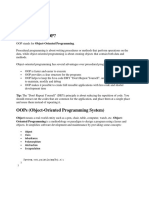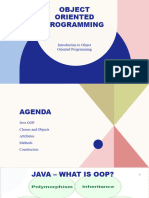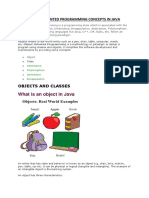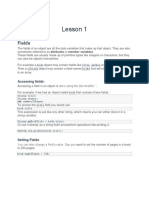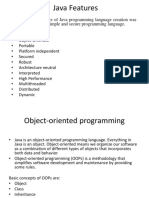0% found this document useful (0 votes)
36 views16 pagesA Lecture Number 4
The document discusses object-oriented programming (OOP) concepts in Java, including:
- OOP stands for object-oriented programming and involves creating objects that contain both data and methods, whereas procedural programming focuses on writing procedures or methods that operate on data.
- Some advantages of OOP include being faster and easier to execute, providing a clear structure, helping to keep code DRY, and making code easier to maintain and modify.
- Classes are templates that define common attributes and behaviors of objects, while objects are specific instances of a class. For example, the Car class could define attributes like color and methods like drive, and individual car objects like myCar could inherit those attributes and methods.
Uploaded by
killerscorpion381Copyright
© © All Rights Reserved
We take content rights seriously. If you suspect this is your content, claim it here.
Available Formats
Download as PDF, TXT or read online on Scribd
0% found this document useful (0 votes)
36 views16 pagesA Lecture Number 4
The document discusses object-oriented programming (OOP) concepts in Java, including:
- OOP stands for object-oriented programming and involves creating objects that contain both data and methods, whereas procedural programming focuses on writing procedures or methods that operate on data.
- Some advantages of OOP include being faster and easier to execute, providing a clear structure, helping to keep code DRY, and making code easier to maintain and modify.
- Classes are templates that define common attributes and behaviors of objects, while objects are specific instances of a class. For example, the Car class could define attributes like color and methods like drive, and individual car objects like myCar could inherit those attributes and methods.
Uploaded by
killerscorpion381Copyright
© © All Rights Reserved
We take content rights seriously. If you suspect this is your content, claim it here.
Available Formats
Download as PDF, TXT or read online on Scribd
/ 16
